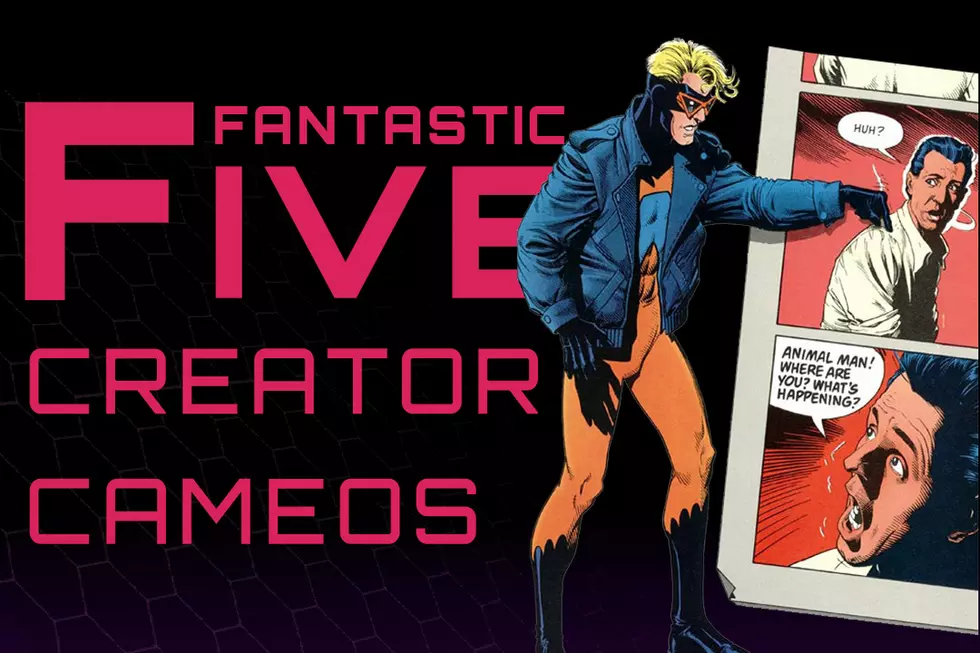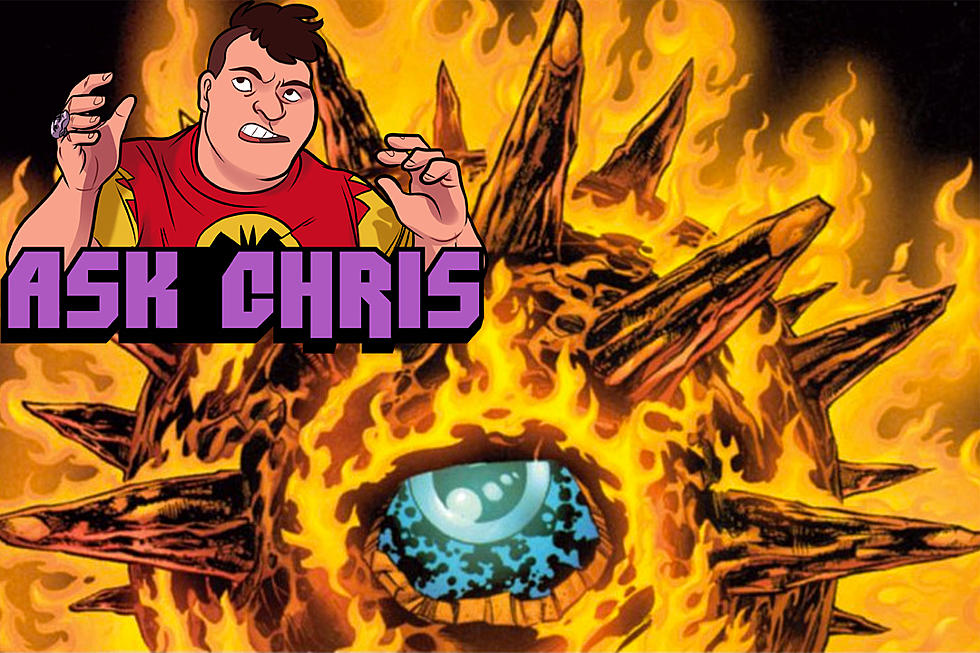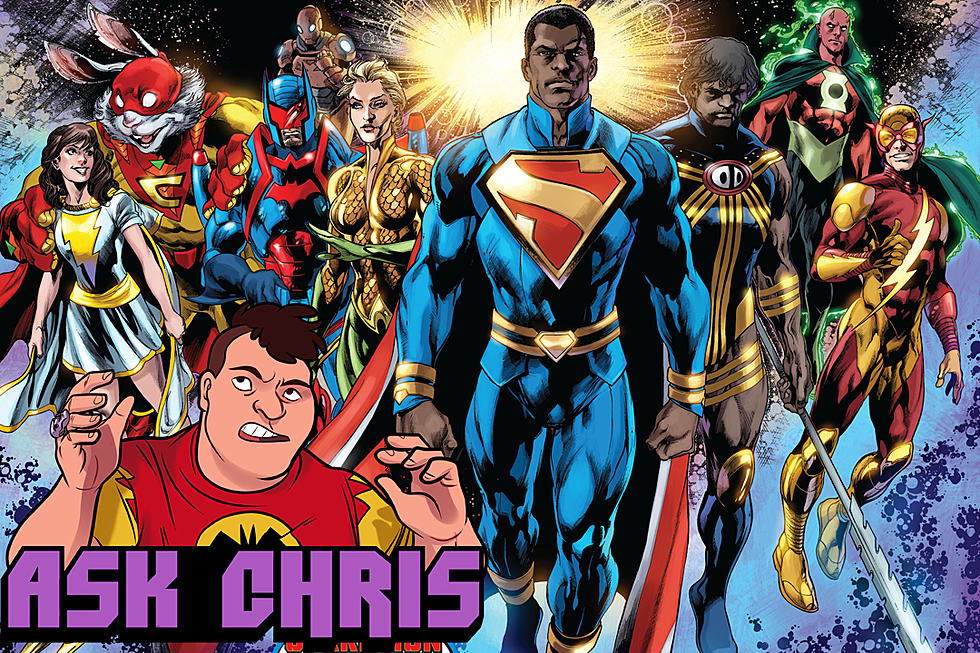
‘Final Crisis': A Timeline Explaining DC’s Most Polarizing Crossover

Perhaps the most most sprawling and continuity-heavy crossover of all time, DC Comics' Final Crisis has already earned its place in comics history as the publisher's most polarizing mainstream works. For every reader who hails the epic's complex story architecture as genius, another decries its inaccessibility. But is it really an incomprehensible swamp of superhero lore? Not with the right road map! Open your heart to the possibilities of a fully-realized reading experience with our Final Crisis timeline after the jump.
Spanning across multiple comic book titles, the Fourth World saga, partially inspired by Kirby's experiences in World War II, envisioned a cosmic conflict amongst gods who used technology rather than magic. At stake was reality and free will itself. Darkseid the Destroyer intended to master the Anti-Life Equation, which would allow him to transform people into his "Justifiers", forced to think as he wished them to think, to act as he wished them to act.
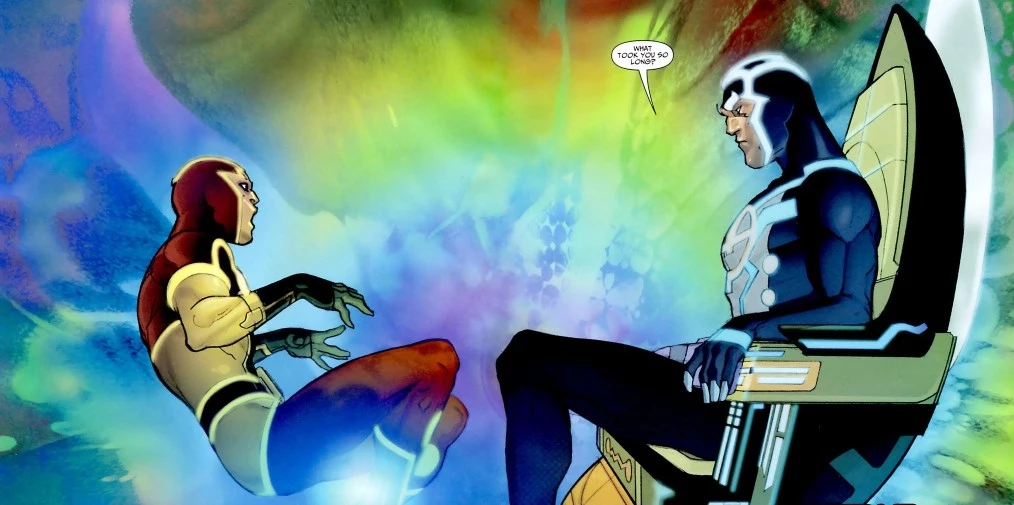
It's been over a year since this major crossover ended, yet readers are still feeling its effects. Grant Morrison recently released two "lost chapters" in the pages of Batman. And Judd Winick gave us a new epilogue in Superman/Batman #76.
So with all these new tie-ins and the fact that it is the anniversary of the Fourth World, it's a good time to travel down a timeline for fans who were confused by marketing, release dates and massive continuity to figure out how the entire Final Crisis crossover fit together -- and it does fit together.

1. 7 SOLDIERS: Mister Miracle #1 - 4
Shilo Norman, apprentice of Scott Free, resumes his role as the third escape artist called Mr. Miracle. While performing a stunt over a controlled black hole, he receives a vision of alternate realities and a future where the New Gods will die but Darkseid will find a way for his spirit to survive in a human host. The visions last for seven days and Metron appears, telling him that this experience was to help him master the Life Equation and become an avatar of freedom, since the New Gods will need a soldier to help fight Darkseid after they're gone.

2. 7 SOLDIERS: Frankenstein #1 - 4
Focusing on adventures of the Frankenstein monster, it is here that fans first learn about the government funded Super-Human Advance Defense Executive (S.H.A.D.E.), which plays a major role in Final Crisis.
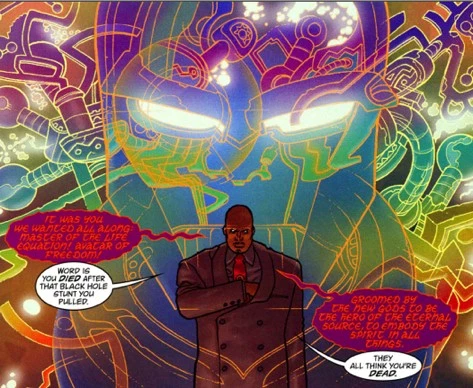
3. 7 SOLDIERS #1
The end of Grant Morrison's epic 7 Soldiers mega-series. Mr. Miracle encounters the gangster Boss Dark Side, who is really Darkseid the Destroyer in a human host. Before Shilo figures out how Darkseid can exist as a spirit on Earth while simultaneously living in his body on the planet Apokolips, the hero gets shot in the head. But having mastered the Life Equation, Shilo escapes death and claws out of his grave. He also helps save Aurakles, who is not only revealed to be Earth's first superhero but is a callback to the character Oracle who appeared in only one story decades ago (when the JLA saved the original Seven Soldiers from being lost in time) and had been forgotten by most fans. Oh, Morrison, you so crazy and I love it.

4. THE OMAC PROJECT #1 - 6
Featuring the origin of the Post-Crisis OMAC units, which play a major role in Infinite Crisis. By the time Final Crisis takes place, S.H.A.D.E. has revised the OMACs into more human-looking forms, referred to as "BIOMACs."

5. The INFINITE CRISIS Crossover
According to statements made by Grant Morrison and DC Co-Publisher Dan DiDio, Infinite Crisis takes place about a week or so after the events of the 7 Soldiers mega-series. A major event from this crossover that bleeds into Final Crisis is the fact that the city of Blüdhaven is laid waste due to the toxic monster Chemo being dropped on it.

6. CRISIS AFTERMATH: Battle for Blüdhaven
This mini-series features the state of Blüdhaven following Infinite Crisis and its evacuation. It also brings back Gardner Grayle, formerly the Outsider known as the Atomic Knight. Now, Grayle has formed a whole army of 125 Atomic Knights that patrol Blüdhaven (which is a re-interpretation of their role Pre-Crisis). Readers also see the Command D bunker, which in another timeline acts as the inspiration for the "last boy on Earth" to be given the name Kamandi. Several elements of this mini-series turn up in Final Crisis and had more readers been aware of it, there would have been less confusion about certain plot points later on.

7. SALVATION RUN #1 - 7
Just over a year after the events of Infinite Crisis, many of Earth's super-villains are deported to an alien world. They war with each other and then find out that the Martian Manhunter J'onn J'onzz, who is also a centuries-long enemy of Darkseid, is among them. Luthor gets everyone home and J'onn is left to starve and wither away in a fiery cage, unable to communicate with anyone who might help him escape.

8. COUNTDOWN TO FINAL CRISIS #51 - 52
Um, yeah. Ignore Countdown. Seriously, it seems like everyone else at DC does and several writers have contradicted many parts of it. If you're desperate to know the basics of what went on, read Greg Cox's novelization instead since it actually finds a way to have most of it make sense.

9. DEATH OF THE NEW GODS #1 - 8
It's time for age of the Fourth World to end and so the New Gods start falling like dominoes. Scott Free resumes his Mr. Miracle role, but then goes a little crazy before he finally meets his end. Darkseid finally learns the Anti-Life Equation. The Source resurrects Orion so he can go kill his evil daddy and readers are left wondering who's gonna win that fight. If you have no idea what a New God is, this story explains everything you need to know and is good prep for Final Crisis.

10. DC UNIVERSE #0
Having existed as pure information and energy since the first Crisis, Barry Allen becomes a human being again. It's implied that this is caused by the multiverse itself, since Barry saved it in the past and now it needs a protector again, but Geoff Johns will later blame his return on Zoom in Flash: Rebirth. As he returns to physical life, Barry sees the past, present and future, getting glimpses of several other DC stories and doing lots of advertising in the process. He finds out that Darkseid's spirit survived physical death at the hands of Orion because it was fueled by the prayers of criminals gathered by his new priest, the old JLA villain Libra. Darkseid's cosmic energies cause his spirit to fall through time, arriving on Earth before the events of the 7 Soldiers crossover began. That's how Shilo met Boss Dark Side over a year before the death of the New Gods. That's just trippy!

11. BIRDS OF PREY #118
Black Alice is kidnapped and taken to the Dark Side Club in New York, where she learns that Boss Dark Side and his cronies are kidnapping young meta-humans. The prisoners are drugged with "Bernadeth's juice" and forced to fight in an arena while becoming loyal to Boss Dark Side and Granny.

12. FLASH #240 - 241
The children of Wally West are captured for the Dark Side Club. While Wally is busy with a battle, the kids are forced to escape on their own, unaware of the full nature of the Club and its intentions.

13. TEEN TITANS #59 - 60
The villain Clock King and his new band of "Terror Titans" attempt to kidnap the Teen Titans for the Dark Side Club, to make them fight in the meta-human arena and drug them into serving the will of Boss Dark Side.

14. BATMAN #676 - 681: Batman R.I.P.
Batman faces Dr. Hurt and the Black Glove group as they attempt to drive him insane with post-hypnotic suggestions, drugs, and live burial. Batman whips them all through a combination of his own bad-ass skills and a violent split personality he deliberately created as a fail-safe if someone attempted mind control on him again (it's happened in the past, after all). He's just that good! Before Dr. Hurt disappears, he claims to put a curse on Batman's cape and cowl and says that the next time the hero wears them will be the last time. During this story, readers are also shown a glimpse of the ending of Batman and Robin #3 which will be published (and take place) months after Final Crisis is over.

15. JUSTICE LEAGUE OF AMERICA #21
The old JLA villain Libra reappears in public for the first time in years, carrying the Crime Bible that was featured in 52 and got its own mini-series. He rescues the Human Flame, a villain so old and obscure that only trivia freaks like myself, Morrison, Robert Greenberger, and Mark Waid didn't have to look him up on Wikipedia. The Human Flame wants revenge on Martian Manhunter, so Libra finally releases the weakened J'onn from his fiery prison and brings him to Earth, leading into Final Crisis #1.

16. BATMAN #701
After the events of Batman R.I.P., Bruce Wayne takes a few days to recover, during which Gotham starts to go nuts and Libra makes his return appearance in the pages of Justice League of America. After his rest period, Batman is told that Orion is dead (again) and that his detective skills are needed on the scene. He dons his (possibly cursed) cape and cowl and this leads us directly to...

17. FINAL CRISIS #1
In the distant past, Anthro, the first boy, is visited by Metron and later has a vision of Kamandi, the last boy. Orion is found dead in Metropolis. After months of being imprisoned and weakened, J'onn is brought to Earth by Libra and speared! The skies are turning red, an indication that reality itself is in trouble. A Monitor becomes human. More Jack Kirby-created characters get involved. Not a single Skrull is spotted.
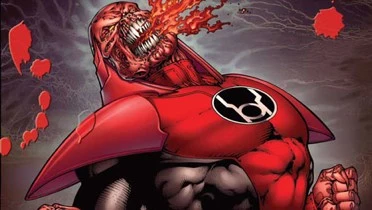
18. FINAL CRISIS: Rage of the Red Lanterns & GREEN LANTERN #35 - 42
In-between discovering Orion's body and finding out that J'onn is dead, Hal Jordan and John Stewart go on a quick mission that introduces them to some new colored Lantern Corps. The story has a lot of rage and some hope with a little bit of avarice. This story has no impact at all on "Final Crisis" and is really just a lead-up to Blackest Night, annoying fans who thought Darkseid might show up.

19. FINAL CRISIS: Requiem
An extended cut of J'onn's death is shown, showing that DC foresaw that some readers might start hating because they thought it happened too quickly. Aquaman shows up at J'onn's funeral in this tie-in and no one seems bothered by this despite the fact that he was still, quite literally and unquestionably, dead when this story was published. Go figure.

20. TERROR TITANS #1 - 6
The events of this mini-series take place after Final Crisis #1. Boss Dark Side seemingly died just after his visit with Dan Turpin, leaving Clock King to take over the Los Angeles branch of the Dark Side Club. In the process, he kills the human hosts of some of Darkseid's forces. This mini-series also features the young hero Static making his debut to the mainstream DC Universe.

21. FINAL CRISIS #2
Morrison introduces the hilarious Super Young Team from Japan. Sonny Sumo, a Kirby-created Japanese fighter who can heal most wounds through mental focus, shows up in Japan even though years ago Darkseid used the Omega Sanction to send him into the distant past. Meanwhile, Batman deduces that Orion was killed by a bullet made from radion (a substance toxic to New Gods) that was fired backwards in time from some point in the future, proving he really IS the world's greatest detective. He's then captured and taken to the Command D bunker in Blüdhaven, which has been turned into the new Evil Factory. Oh, and the Flashes meet at a strip club, a place where women flash customers.

22. FINAL CRISIS: Rogues' Revenge #1 - 3
The Rogues decide they aren't going to play Libra's reindeer games anymore and wind up having to face their would-be replacements, as well as the psycho speedsters Inertia and Zoom. This mini-series doesn't affect the main storyline, but the Rogues kick a lot of ass in it, Libra has some fun scenes, there are things that will genuinely surprise you, and it reminds you why Barry Allen is important.

23. FINAL CRISIS #3
The body of Boss Dark Side is finally found in the abandoned and boarded up New York branch of the Dark Side Club. Alan Scott uses Article X (which has been barely mentioned since DC's All-Star Squadron series ended) to gather the heroes into an army, as was done by FDR during World War II. Libra shows he's a bastard even to his lackeys. The Source Wall reappears and goes digital, signaling that things are going to Hell. Oracle notes the presence of a new Aquaman. The Anti-Life Equation launches, causing most of the Earth to fall under Darkseid's will. Bad times.

24. FINAL CRISIS: Superman Beyond #1-2
Superman joins parallel universe counterparts in a yellow submarine that travels through the Bleed. The true origin behind the Monitors is discovered and Superman learns about Mandrakk, a vampire Monitor who feeds on the life essence of entire universes even as he limits their growth, similar to how Edward Cullen has been sucking the cool out of the vampire genre. There's also a fun callback to one of Morrison's most famous issues of Animal Man.

25. FINAL CRISIS: Revelations #1-5
Takes place during the days immediately following the Anti-Life Equation being unleashed. The Spectre and Libra throw down. Readers meet a new angelic hero called the Radiant who helps deal with the chaos. And turns out the Biblical story of Cain was based on a DC super-villain.

26. FINAL CRISIS: Secret Files
For those who weren't sure who Libra was, this explains his history while revising it slightly and revealing at last how he got mixed up with Darkseid. The only reason I don't suggest reading this before Final Crisis #1 is that it gives away some details of issues #1 and #3.

27. FINAL CRISIS: Resist
Summarizes Checkmate, Snapper Car and others dealing with the weeks following the Anti-Life Equation transmission. Mr. Terrific decides to dust off the old OMACs that caused such a fuss during Infinite Crisis. And Snapper Carr and Cheetah get nekkid, as responsible adults sometimes do when they love each other very much or have had at least a few drinks.

28. FINAL CRISIS: Submit
Black Lightning kicks a lot of ass and runs into the Tattooed Man and his family. He gives T-Man a design that can be used against Darkseid (Metron's circuit), but is then captured and turned into a Justifier.

29. FINAL CRISIS #4
A month after the Anti-Life Equation was broadcast worldwide, Turpin finally submits to Darkseid's possession. Humanity is struggling to survive in a world ruled by evil, Superman is missing, and most people on Earth are now working as evil Justifiers. Alan Scott rallies Earth's heroes because he's awesome like that. Then the sky starts bleeding, which is totally messed up. Oh, and some readers complain that Hourman's colors are wrong, showing their ignorance of the fact that the original Hourman returned to life some time before "Final Crisis" began and thus the colors are correct.

30. FINAL CRISIS #5
The heroes make a final stand in the ruins of Blüdhaven as readers get more references to old Kirby stories. The Green Lantern Corps is on its way. Batman escapes the Evil Factory. Nix Uotan regains his power when he meets the new incarnation of Metron, who told us a long time ago that he wasn't actually a New God and would survive in some form even after they were all gone. And Metron turns up with a Mother Box disguised as a Rubik's Cube, which is just funny.

31. BATMAN #698 - 683
This two-part interlude shows Batman's imprisonment in the Evil Factory from Final Crisis #2 up to his escape in #5. He's put through virtual reality simulations that twist his memories to resemble many Pre-Crisis stories. Bruce realizes that this is being done by Scott Free's old enemy the Lump, a mind-leech. Before escaping, Bruce takes out a clone army of evil Batmen through a combination of will and his own memories. Clever move, Detective!

32. FINAL CRISIS #6
The villains start turning on each other. Grant Morrison explains why Orion seemingly died a few times rather than complaining that other writers shouldn't have been mucking about with the New Gods. Batman uses the radion bullet to poison Darkseid's host body and then gets zapped with the Omega Sanction, which 7 Soldiers: Mister Miracle told us was an attack that exiles you through time and space. Superman returns from an untold adventure and finds a Batman-like corpse, which has his exact DNA (as revealed in Batman and Robin #7) and has every wound that he suffered from over the years (as later revealed in Batman and Robin #8 and Superman/Batman #76). Readers also get to see the Miracle Machine again, a device introduced in 1968 and remembered by only the most die hard fans of the Legion of Super-Heroes. And it turns out the Question is the inspiration for the faceless enforcers of the Global Peace Agency, originally seen in Jack Kirby's OMAC series.

33. BATMAN AND ROBIN #8
Okay, this story definitely takes place many months AFTER Final Crisis. However, it does contain a flashback for anyone curious as to why one of Mokkari's Batman clones survived and how it came to possess all of Batman's old wounds, confirming that Darkseid is just as good as Batman when it comes to multiversal chess games.

34. FINAL CRISIS #7
Time and space are collapsing as long as Darkseid's spirit still exists. Heroes and scientists make preparations so that humanity will survive no matter what. After Darkseid is defeated, Mandrakk shows up in a last ditch effort to feed off of the energies of the now-weakened DC Universe. Battles are fought and won. The Global Peace Agency and others arrive on the reborn Earth-51, which is apparently where Jack Kirby's classic series of Kamandi and OMAC take place. In the distant past of the mainstream DC Earth, Anthro dies an old man just as Bruce Wayne appears.

35. SUPERMAN/BATMAN #76
The day after Darkseid and Mandrakk are defeated, Superman informs Dick Grayson, Alfred Pennyworth, and Tim Drake about Bruce Wayne's apparent death. Dick is initially as skeptical as most DC readers were about this news. The latter half of this story takes place after "Battle for the Cowl," when Dick Grayson decides it's up to him to become the new Batman.

36. FINAL CRISIS: Legion of Three Worlds
Soon after Darkseid's defeat, Superman is called into the 31st century and helps out another multiversal crisis happening in the future, focusing on the Legion. This story doesn't really have anything to do with the main Final Crisis tale and the way it shows Superman and others returning to the present day at the end directly contradicts how Superman returns to the present in Final Crisis #6 (further explanations are below), so don't be fooled by its title. It is, however, an enjoyable read and a must for Legion, Superboy and Flash fans.

37. BATMAN #702
Events from Final Crisis #1, 2, 5, 6 and 7 are retold from Batman's perspective. Bruce leaves a recorded message for his friends in the future to find, a message that leads directly into "The Return of Bruce Wayne."

38. DC UNIVERSE: Last Will and Testament
Yeah... This doesn't fit. It just doesn't. I've read this comic book three times over, taking notes. I've tried and tried and tried to make it fit into a Final Crisis timeline. It doesn't work. It opens up saying that the heroes expect the world to end the next day, which implies this takes place before Darkseid's final defeat in Final Crisis #7 when reality is collapsing, except that Bruce Wayne is seen alive and well in this issue. Also, Tim Drake and Black Lightning should both still be Justifiers if that's when this issue takes place. Another thing, readers know from the Superman comics that Bruce Wayne and Clark Kent talked about the death of Pa Kent, meaning the man must have died soon before Final Crisis began or the two heroes wouldn't have had time for this conversation. So how can Jonathan Kent be in this issue? And hey, why does Deathstroke assume that Geo-Force doesn't know his own country's native tongue? Nothing against Brad Meltzer, it's just that this story needed some editing. It simply doesn't work with everything else that was happening.
And that wraps it all up, as it were. Now, of course, some of you are probably wondering how it's known what issue occurs when. Well, some issues specifically tell you when they occur in relation to each other if you simply read the dialogue and captions carefully. Other issues, some comic book detective work was involved. For instance...
FINAL CRISIS: Rage of the Red Lanterns - In the Rage of the Red Lanterns one-shot, Hal mentions that Orion's body has been found but he doesn't mention J'onn's fate at all and Earth has clearly not yet been quarantined by the Alpha Lanterns. The Rage of the Red Lanterns story leads directly into the Agent Orange storyline in the main Green Lantern title and it is clear during all of this that Hal does not have a chance to return to Earth until after the events of Green Lantern # 42. In Final Crisis # 1, readers are not specifically told how much time passes between Page 15 (when Hal and John call-in Orion's body) and Page 16 (when Dr. Light and Mirror Master find the Mobius chair). If readers assume that at least a full day passes in between those pages, that gives Hal and John just enough time for their adventures against the Red Lanterns and Larfleeze. This isn't that far out there as theories go. An issue of Batman R.I.P. looked as if it took place over a day or two and Grant Morrison later revealed that actually five days had passed for the characters.
FINAL CRISIS: Rogues' Revenge - At the beginning of the story, the Rogues have recently left Libra's employ, so this must take place after the scene in Final Crisis #2 when they are depicted to still be working with him. Since the anti-life equation hasn't been unleashed on Earth yet, it takes place before issue Final Crisis #3.
FINAL CRISIS: Legion of Three Worlds - Despite the title, this mini-series cannot take place during Final Crisis because Superman is gone for much of the story and doesn't return until issue #6, when Darkseid has already taken over the Earth. In Red Robin #3, in a flashback scene that takes place days after Final Crisis, Wonder Girl discusses Batman's apparent death and bring up the fact that Superboy and Bart Allen both died and have not yet come back. And when we see Superman and friends return to the modern-day at the end of this mini-series, they have time to have a happy reunion and the world seems normal, contradicting how Superman arrives in the modern-day (alone) during the end of the FInal Crisis. Therefore, Legion of Three Worlds has to take place after Final Crisis #7. Which means that the scene at the beginning of Final Crisis #6 (where Superman mentions that he just had an adventure with the Legion) refers to some other untold story. That's not what Morrison intended, but since no one apparently told Geoff Johns or others at DC, that's how has to play out to make sense.
And that's Final Crisis, folks!
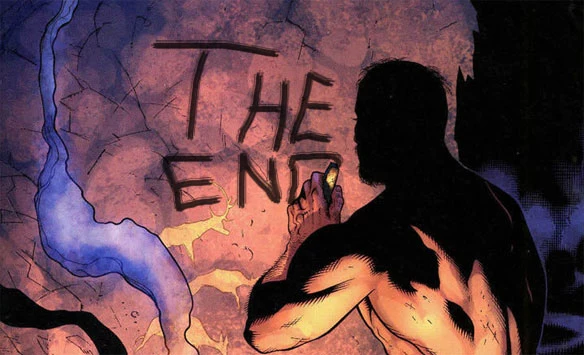
Alan Kistler is a comic book historian, freelance writer and actor living in New York. He is the creator of the web series Crazy Sexy Geeks, the writer of the comic book fashion column Agent of S.T.Y.L.E.
More From ComicsAlliance




